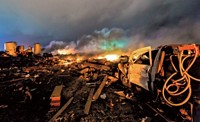Advertisement
Grab your lab coat. Let's get started
Welcome!
Welcome!
Create an account below to get 6 C&EN articles per month, receive newsletters and more - all free.
It seems this is your first time logging in online. Please enter the following information to continue.
As an ACS member you automatically get access to this site. All we need is few more details to create your reading experience.
Not you? Sign in with a different account.
Not you? Sign in with a different account.
ERROR 1
ERROR 1
ERROR 2
ERROR 2
ERROR 2
ERROR 2
ERROR 2
Password and Confirm password must match.
If you have an ACS member number, please enter it here so we can link this account to your membership. (optional)
ERROR 2
ACS values your privacy. By submitting your information, you are gaining access to C&EN and subscribing to our weekly newsletter. We use the information you provide to make your reading experience better, and we will never sell your data to third party members.
Industrial Safety
EPA revises Obama-era industrial safety regulation
Updated following the West, Texas, fertilizer explosion, rule is intended to prevent incidents at facilities handling large amounts of hazardous materials
by Jeff Johnson
May 18, 2018

The Environmental Protection Agency has reproposed a controversial regulation intended to protect communities, workers, and emergency responders by preventing accidents at chemical plants, refineries, and other facilities that handle large amounts of hazardous and potentially dangerous chemicals. The regulation was issued in the last days of the Obama administration but put on hold last year by incoming EPA Administrator Scott Pruitt.
Pruitt’s rewrite removes several provisions pushed by community and worker advocates. It rescinds accident-prevention provisions that require independent root-cause accident investigations, third-party process audits, and consideration of the use of safer alternative manufacturing technologies, according to an EPA summary. It also removes requirements that would have made some plant-supplied information public, citing security concerns. Additionally, the rewrite eliminates several provisions calling for greater emergency response coordination, again citing security concerns.
Overall, the changes focus on a 25-year-old provision of the Clean Air Act called the Risk Management Program (RMP). RMP covers some 12,500 facilities that, according to EPA, reported 1,500 accidents over a recent 10-year period. These incidents caused nearly 60 deaths, 17,000 injuries, the evacuation of 500,000 people, and property damage of more than $2 billion.
It was a serious accident in 2013 that triggered then-president Barack Obama to order a federal review of community and worker safety regulations. That accident killed 15 people, including 13 emergency responders, when ammonium nitrate fertilizer exploded at a Texas retail farm-supply warehouse. Following a three-year federal agency examination, the RMP regulation was modified; it was the only regulation to emerge from the federal review.
Pruitt’s RMP revisions were heralded by industry stakeholders, particularly the Society of Chemical Manufacturers & Affiliates (SOCMA), which said it had major concerns with the Obama-era rule. Those concerns mirrored the changes Pruitt made. “We look forward to working with EPA on other issues of mutual interest,” SOCMA said in a statement. SOCMA announced the release of the proposed rule before EPA did.
In contrast, the BlueGreen Alliance of U.S. community and union members who took part in Obama’s review notes in a statement that at least one in three schoolchildren live in the vulnerability zone of a hazardous facility, and that at least two dozen accidents have occurred since Pruitt first delayed the regulation a year ago. “Now, Administrator Pruitt is attempting to further weaken these safeguards,” the alliance says.
EPA estimates that companies will save some $88 million annually in regulatory costs if Pruitt’s changes are finalized. The public has 60 days to comment on the reproposal.





Join the conversation
Contact the reporter
Submit a Letter to the Editor for publication
Engage with us on Twitter